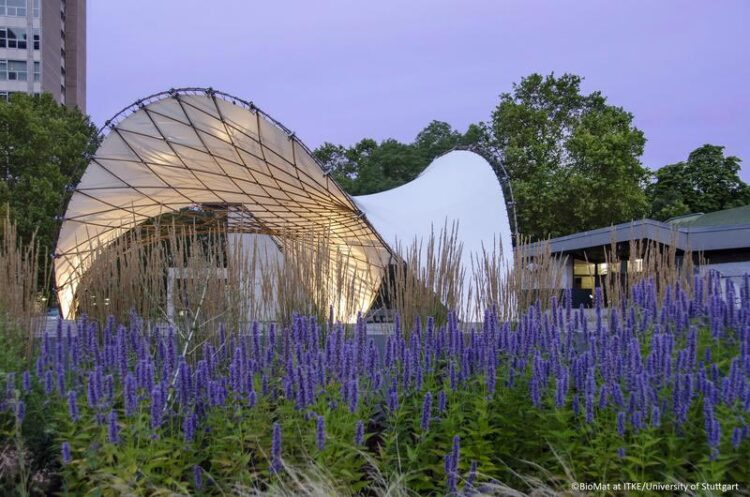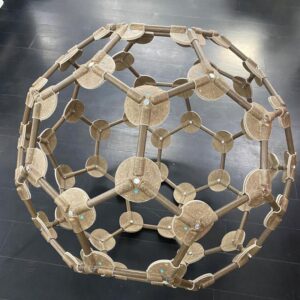Biocomposite at the Venice Architecture Biennale

Pavilion 2021 LightPRO Shell
(c) BioMat/ITKE- University of Stuttgart
This year’s Venice Architecture Biennale sees itself as a “Laboratory of the Future”. Bio-composites are not just dreams of the future in architecture.
The German Institutes of Textile and Fiber Research (DITF) have developed a sustainable material for support profiles and connecting nodes, which will be on display at Palazzo Mora during the Biennale from May 20 to November 26. The ultralight components are the result of a joint project between partners from research and industry, funded by the German Federal Ministry of Food and Agriculture. In the future, they will be used in the field of mobile architecture and in pavilions and architecture with low load-bearing capacity.
The DITF had the task of selecting suitable materials for the biocomposite and developing manufacturing processes. In order to achieve the highest possible organic content, hemp and flax fibers and a resin system based on epoxidized linseed oil were used. These natural resources were used in both pultrusion and hotpressing processes.

(c) Carsten Fulland / Zenvision
Processing natural fibers into high-performance products is challenging because they are thicker, more uneven, wetter and also more sensitive than high-performance fibers made of glass, carbon or aramid. To date, natural fibers have been predominantly pultruded using petroleum-based resins or resins with a very low bio-content. The resulting composites did not achieve sufficient fiber-matrix adhesion, which is why the mechanical properties were unsatisfactory. At the DITF, these material- and process-related problems were largely solved.
For example, the pre-drying of the natural fiber rovings in pultrusion was a decisive solution. What was successful on a laboratory scale at the DITF could also be implemented on an industrial scale. For the LightPRO Shell Pavilion, the Buckyball and for the Biennale exhibition, project partner CG-TEC produced a total of 800 meters of tubular profile, which was used as a support element. For the node connecting the support profiles, the project partners created a design, based on which a suitable molding tool for the hotpressing process was produced. At the end of the project, more than 60 connecting nodes for the buckyball were produced at the DITF using this molding tool, a section of which can now be viewed in Venice.
Practical tests have shown that the biocomposite material developed at DITF is suitable for a wide range of architectural applications. Compared to fiberglass plastics, biocomposites do not splinter in a crash. They are also a sustainable building material. They consume much less energy in their production and sequester a large amount of carbon in the long term. Due to their low density, they weigh little and are therefore suitable for many lightweight construction applications. The aim of lightweight construction is to save raw materials, energy and thus costs. The use of biocomposites offers the construction industry great potential for treading new resource-saving paths.
The LeichtPRO research project was funded by the Agency for Renewable Resources (FNR) on behalf of the German Federal Ministry of Food and Agriculture.
Wissenschaftliche Ansprechpartner:
Patrick Kaiser M.Sc.
Competence Center Polymers & Fiber Composites
Composite Technology / Braiding Technology
T +49 (0)711 93 40-482
E patrick.kaiser@ditf.de
Prof. Dr.-Ing. Markus Milwich
Head of Competence Center Polymers and Fiber Composites
T +49(0)711 9340-164
E markus.milwich@ditf.de
Media Contact
All latest news from the category: Architecture and Construction
Newest articles

First-of-its-kind study uses remote sensing to monitor plastic debris in rivers and lakes
Remote sensing creates a cost-effective solution to monitoring plastic pollution. A first-of-its-kind study from researchers at the University of Minnesota Twin Cities shows how remote sensing can help monitor and…

Laser-based artificial neuron mimics nerve cell functions at lightning speed
With a processing speed a billion times faster than nature, chip-based laser neuron could help advance AI tasks such as pattern recognition and sequence prediction. Researchers have developed a laser-based…

Optimising the processing of plastic waste
Just one look in the yellow bin reveals a colourful jumble of different types of plastic. However, the purer and more uniform plastic waste is, the easier it is to…



